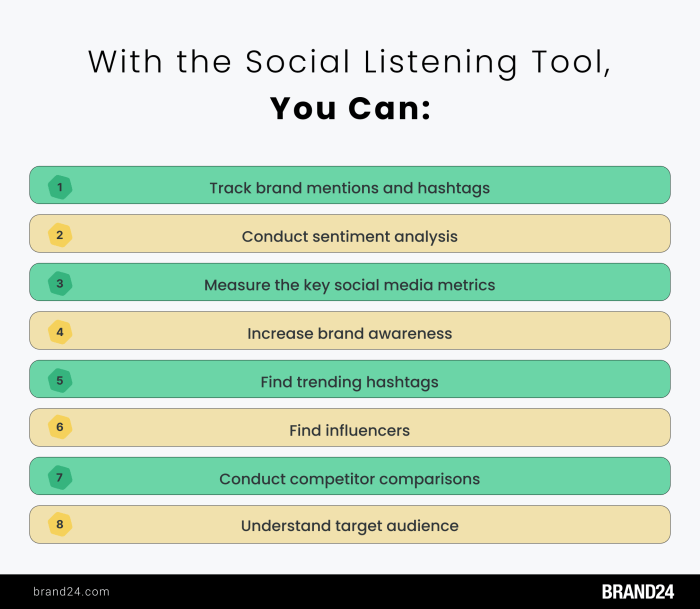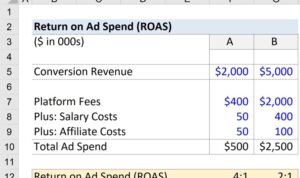Using Social Listening Tools dives deep into the world of digital insights, offering a fresh perspective on understanding audience behavior and brand sentiment in today’s fast-paced digital landscape.
Get ready to explore the power of social listening tools and how they can revolutionize your marketing strategies!
Introduction to Social Listening Tools

Social listening tools are software platforms that allow individuals and businesses to monitor and analyze conversations and trends happening on social media platforms. These tools help track mentions of specific s, brands, products, or industries, providing valuable insights into customer sentiment, preferences, and behavior.
In today’s digital landscape, where social media plays a significant role in shaping public opinion and influencing consumer decisions, using social listening tools is crucial for businesses to stay competitive and relevant. By listening to what customers are saying on social media, companies can better understand their needs, address their concerns, and tailor their marketing strategies to meet their expectations.
Examples of Popular Social Listening Tools
- Sprout Social: A comprehensive social media management platform that offers robust listening capabilities to track brand mentions, industry trends, and competitor activity.
- Hootsuite: A widely used social media management tool that includes social listening features to monitor conversations, hashtags, and s across multiple platforms.
- Brandwatch: An advanced social listening tool that provides real-time insights into consumer behavior, market trends, and brand reputation through sophisticated data analytics.
- Awario: A social media monitoring tool that helps businesses track mentions, monitor influencers, and analyze sentiment to optimize their social media strategies.
Benefits of Using Social Listening Tools
Social listening tools offer numerous advantages for businesses looking to better understand their target audience and improve their online presence. These tools provide valuable insights that can inform marketing strategies, enhance customer engagement, and drive business growth.
Understanding Target Audience
Social listening tools allow businesses to gain a deep understanding of their target audience by analyzing conversations, trends, and sentiments shared online. By monitoring discussions on social media platforms, forums, and review sites, companies can identify key demographics, preferences, and pain points of their customers. This valuable data enables businesses to tailor their products, services, and messaging to better meet the needs of their audience.
Tracking Brand Sentiment
One of the key benefits of social listening tools is the ability to track brand sentiment in real-time. By monitoring mentions of their brand name and related s, businesses can gauge the overall perception of their brand among consumers. This allows companies to quickly address any negative feedback or issues, as well as capitalize on positive sentiment to strengthen brand loyalty and reputation.
Monitoring Online Conversations
Social listening tools also enable businesses to monitor online conversations about their industry, competitors, and relevant topics. By staying informed about industry trends, consumer preferences, and competitor strategies, companies can identify opportunities for growth, innovation, and differentiation. This valuable intelligence can inform content creation, campaign planning, and overall business strategy.
Features to Look for in Social Listening Tools
When choosing a social listening tool, it’s important to consider the key features that make it effective in monitoring and analyzing online conversations. These features can vary from one tool to another, so it’s essential to compare them based on their functionalities and capabilities. Real-time monitoring and analytics play a crucial role in providing insights into consumer behavior and sentiment towards a brand or product.
Real-time Monitoring
Real-time monitoring is a critical feature to look for in social listening tools as it allows businesses to track conversations as they happen. This feature enables brands to stay updated on trending topics, monitor brand mentions, and respond promptly to customer feedback or complaints. By monitoring in real-time, businesses can address issues quickly and capitalize on opportunities as they arise.
Analytics Capabilities
Another important feature to consider is the analytics capabilities of a social listening tool. Effective tools should provide detailed insights and data analysis to help businesses make informed decisions. These analytics can include sentiment analysis, demographic information, influencer identification, and trend analysis. By utilizing these analytics, businesses can better understand their target audience and tailor their marketing strategies accordingly.
Customization Options
Look for social listening tools that offer customization options to meet the specific needs of your business. Whether it’s setting up custom alerts, creating personalized reports, or integrating with other tools, the ability to customize the tool to your requirements is essential for maximizing its effectiveness. Customization options allow businesses to focus on the metrics and data that are most relevant to their goals.
Integration with Other Platforms
Consider social listening tools that offer integration with other platforms such as CRM systems, marketing automation tools, or social media platforms. Seamless integration allows businesses to streamline their processes, centralize data, and improve overall efficiency. By integrating social listening tools with other platforms, businesses can gain a more comprehensive view of their audience and enhance their overall marketing efforts.
User-Friendly Interface
Lastly, choose a social listening tool with a user-friendly interface that is easy to navigate and understand. A user-friendly interface ensures that businesses can easily access and interpret the data provided by the tool without the need for extensive training. Intuitive dashboards, customizable reports, and clear visualizations can help businesses make sense of the data and take actionable steps based on the insights gained.
Best Practices for Utilizing Social Listening Tools
Effective use of social listening tools can provide valuable insights for businesses. Here are some best practices to maximize the benefits:
Tips for Setting Up Effective Searches and Filters, Using Social Listening Tools
- Use specific s related to your industry, brand, or products to narrow down relevant conversations.
- Utilize Boolean operators (AND, OR, NOT) to refine search results and exclude irrelevant content.
- Create filters based on factors like sentiment, location, language, and date to focus on the most important data.
Strategies for Turning Data into Actionable Insights
- Identify trends and patterns in the data to understand customer preferences and sentiment towards your brand.
- Segment the data to target specific audience groups and tailor marketing strategies accordingly.
- Monitor competitor activity and analyze their social mentions to identify areas for improvement or differentiation.
Significance of Integrating Social Listening Data with Other Marketing Efforts
- Combine social listening insights with customer feedback and market research to develop a comprehensive understanding of consumer behavior.
- Use social listening data to inform content creation, campaign planning, and product development strategies.
- Integrate social listening data with CRM systems to personalize customer interactions and improve overall customer experience.
Case Studies and Examples: Using Social Listening Tools

In this section, we will explore how companies have utilized social listening tools to enhance their products and services, handle crises, manage their reputation, and boost influencer marketing.
Improving Products and Services
- Company X used social listening tools to track customer feedback on social media and identify areas for improvement in their products. By analyzing the sentiments and comments of their customers, they were able to make necessary adjustments to meet customer needs and preferences.
- Through social listening, Company Y discovered a demand for a new feature in their software that was not previously offered. By quickly responding to this feedback, they were able to develop and launch the feature, leading to increased customer satisfaction and loyalty.
Crisis Management and Reputation Building
- During a PR crisis, Company Z monitored social media conversations using social listening tools to gauge public sentiment and address concerns promptly. By actively engaging with customers and providing transparent communication, they were able to mitigate the negative impact on their reputation.
- Company A faced a product recall situation, but by leveraging social listening tools to identify affected customers and communicate with them directly, they were able to restore trust and loyalty in their brand. The real-time insights helped them tailor their responses effectively.
Influencer Marketing Success Stories
- Brand B collaborated with influencers whose followers aligned with their target audience, identified through social listening tools. By analyzing the influencers’ engagement rates and audience demographics, they were able to execute successful campaigns that drove brand awareness and increased sales.
- Through social listening tools, Brand C identified micro-influencers with highly engaged followers who had a genuine interest in their niche products. By partnering with these influencers, they were able to create authentic content that resonated with their audience and generated a significant ROI.





